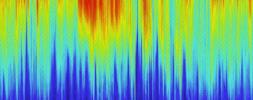The SNMREC Preferred Partner Program is an opportunity for our industry partners to collaborate more fully with the Center. This program is designed to dedicate SNMREC experts and resources to individual industry partner development needs.
News

FAU's SNMREC Achieves Major Milestone
BOCA RATON, FL (April 18, 2011) — The Southeast National Marine Renewable Energy Center (SNMREC) at Florida Atlantic University recently accomplished a major milestone in the establishment of its testing capabilities. The Center successfully completed offshore testing of a key component of its small-scale ocean-current turbine test berth – a Mooring and Telemetry Buoy (MTB). The MTB test was the first step of a multi-phase strategy to create a real-time offshore ocean energy test facility and scientific observatory.
The MTB was tow-tested offshore of Fort Pierce, where Harbor Branch Oceanographic Institute engineers and SNMREC engineers joined the crew of the M/V Thunderforce to verify buoy performance as designed.
“The test was a success because the predicted behavior of the buoy matched closely with the measured behavior during testing” said Bill Baxley, chief engineer at SNMREC. “The test showed that the buoy performs as it was designed for its eventual offshore deployment.”
The steel-hulled buoy is approximately 21 feet long and 10 feet wide, and its unique hull design is shaped to survive strong currents. Onboard the buoy, there are a variety of renewable power sources such as solar panels, small wind turbines and sailboat water turbines that provide power for onboard oceanographic instruments, safety and navigation systems, and wireless communication. The safety and navigation systems include active radar target enhancers and a Class “A” Automatic Identification System transmitter. Wireless communication systems also are included to relay collected data to shore and to provide the ability to monitor buoy health remotely.
The M/V Thunderforce, with support from a Boat U.S. vessel, towed and tested the buoy offshore. Upon reaching the predetermined location in the Gulf Stream about 18 miles east of Fort Pierce, the buoy attachment was reconfigured. The test configuration, which emulates how the buoy would be anchored offshore, was used to determine how the buoy would behave under various current speed and sea heading conditions. The objectives of the MTB system tow tests were to verify buoy stability, tracking and wave response, as well as to verify onboard scientific instrument functionality and planned maintenance procedures.
“This success is an important step toward realizing the testing facility that we have been envisioning and to provide the nation with its first offshore ocean current generator test berth,” said Susan Skemp, executive director of the SNMREC at FAU.
Engineers now plan to make minor modifications based upon test results to improve performance and will complete final integration of the measurement, communication and power systems. After this phase, the Center will be ready to anchor the buoy offshore this summer.
Video footage from the test is available online at http:www.eng.fau.edu/SNMREC/BuoyTowTest1 .
For more information, contact Susan Skemp at 561-297-2339 or sskemp@fau.edu .
-FAU-
About the Southeast National Marine Renewable Energy Center at FAU:
In August 2010, the U.S. Department of Energy (DOE) designated FAU’s Center for Ocean Energy Technology as a national center for ocean energy research and development. The new Southeast National Marine Renewable Energy Center (SNMREC) at FAU joins centers in the Pacific Northwest and Hawaii that also work to advance the operational readiness of ocean energy technologies. DOE is funding the SNMREC to undertake research and development of technologies capable of generating renewable energy from ocean currents and ocean thermal energy. The SNMREC is collaborating with industry partners to investigate, refine, fabricate and test promising next-generation water power technologies to harness the ocean’s vast energy potential. The Center’s researchers have already begun this work by deploying ocean current observation systems, establishing research on environmental baselines to determine the level of potential effects, and initiating the fabrication of support structures for ocean energy devices. The Center will ultimately perform full-scale field testing of prototype devices, an important step toward the successful development of innovative new ocean energy systems. As a public institution of higher education, FAU is also promoting public awareness of ocean energy research and development, and is developing curricula for the education of a workforce for this new industry. Formerly called the Center for Ocean Energy Technology, the Center was founded with a $5M award from the State of Florida in January 2007, and was established to research, design, develop, implement, and test ocean energy technologies that are cost-competitive with existing power technologies. snmrec.fau.edu
About Florida Atlantic University:
Florida Atlantic University, established in 1961, officially opened its doors in 1964 as the fifth public university in Florida. In commemoration of its origin, FAU is celebrating its 50th anniversary throughout 2011. Today, the University serves more than 28,000 undergraduate and graduate students on seven campuses and sites. FAU’s world-class teaching and research faculty serves students through 10 colleges: the Dorothy F. Schmidt College of Arts & Letters, the College of Business, the College for Design and Social Inquiry, the College of Education, the College of Engineering & Computer Science, the Graduate College, the Harriet L. Wilkes Honors College, the Charles E. Schmidt College of Medicine, the Christine E. Lynn College of Nursing and the Charles E. Schmidt College of Science. FAU is ranked as a High Research Activity institution by the Carnegie Foundation for the Advancement of Teaching. For more information, visit www.fau.edu
To view the original Press Release: http://www.fau.edu/mediarelations/Releases0411/041119.php



